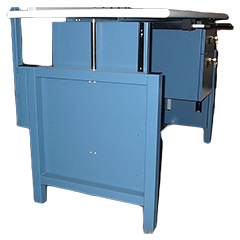Workplace safety isn’t just about hard hats and steel-toed boots anymore. In today’s hybrid and desk-centric work environments, safety also means protecting employees from long-term injuries caused by poor posture, repetitive strain and eye fatigue.
Whether your team is in a lab, office or working remotely, integrating ergonomic design into your workspace is more important than ever.
Musculoskeletal disorders can cost thousands in medical expenses and lost productivity. This impact hits both employees and employers hard.
By proactively designing workspaces that support natural body positioning, reduce repetitive stress and improve comfort, businesses can reduce injuries, boost employee well-being and even improve performance. Here's how ergonomic design can play a central role in your workplace safety strategy.
Ergonomic Workstation Seating
Choosing the right ergonomic chair is the foundation of a safe workstation. Employees who sit for long hours need seating that supports proper posture and reduces the risk of injury. Look for chairs or stools with multiple points of adjustability, including:
that supports proper posture and reduces the risk of injury. Look for chairs or stools with multiple points of adjustability, including:
- Armrest height and width
- Seat height and depth
- Lumbar (lower back) support
- Backrest angle
Adjustable features ensure users can keep their feet flat on the floor, knees at a 90-degree angle, and shoulders relaxed. This reduces strain on the neck, shoulders, and lower back — common areas affected by poor posture.
Height Adjustable Worksurfaces
Height adjustable desks and workbenches have become essential in modern workplace design. These desks allow users to alternate between sitting and standing, promoting better circulation and reducing the risks associated with prolonged sitting.
to alternate between sitting and standing, promoting better circulation and reducing the risks associated with prolonged sitting.
Adjustable height workbenches feature both versatility and ergonomic benefits. They accommodate workers of different heights while supporting both sitting and standing positions. Here are a few considerations to keep in mind while selecting a height adjustable worksurface:
- Electric vs. Manual Adjustment: Electric height-adjustable workbenches offer convenience and precision, while manual options are more budget-friendly but can require more effort to adjust.
- Sit-Stand Compatibility: Sit-stand workstations promote movement throughout the day, reducing the health risks associated with prolonged sitting or standing.
- Weight Capacity: Ensure the adjustable mechanism can support the weight of the tools and materials typically used on the industrial workbench.
Height-adjustable workbenches also provide a customized setup for employees of all heights. This is especially helpful in shared workspaces or for individuals who need to match the height of their desk to the position of their monitor and keyboard for optimal posture.
Monitor Arms For Improved Screen Positioning
Proper monitor positioning is crucial for avoiding neck and shoulder strain. The top of the screen should sit just below eye level when the user is seated upright. Monitor arms make this possible by allowing users to easily adjust the height, tilt, and distance of one or more screens.
Monitor arms are especially beneficial in shared office environments and lab settings where multiple users interact with the same equipment.
Keyboard Trays for Wrist and Shoulder Alignment
Typing for extended periods without proper support can lead to wrist pain, nerve compression and long-term injuries like carpal tunnel syndrome. Keyboard trays help by keeping wrists in a neutral position and shoulders relaxed.
For workstations that aren’t height adjustable or are shared by multiple employees, keyboard trays offer an easy way to adapt the typing position for different users, reducing strain and promoting healthier movement.
Ergonomic Workstation Accessories
Accessories play a vital role in completing an ergonomic setup. Here are a few accessories that can enhance workplace safety and comfort:
- Under-cabinet lighting to reduce eye strain
- Document holders to avoid unnecessary reaching or bending
- Headsets to prevent neck pain caused by cradling a phone
- Mounted bins, shelves and drawers to keep supplies within easy reach and reduce repetitive strain from bending or twisting
These small enhancements can have a big impact on employee well-being and productivity.
Designing with Ergonomics in Mind
Whether you're setting up an office, lab or industrial workbench, designing with ergonomics in mind from the start leads to a safer, more productive environment. It also reduces costly workplace injuries and promotes employee retention by showing that their health and comfort matter.
Implementing ergonomic design isn’t just about comfort — it’s a proactive step toward workplace safety and injury prevention. From seating and monitor placement to accessories and adjustable desks, every component plays a role. By focusing on these key ergonomic principles, you can create a workspace that protects your team and supports long-term wellness.


